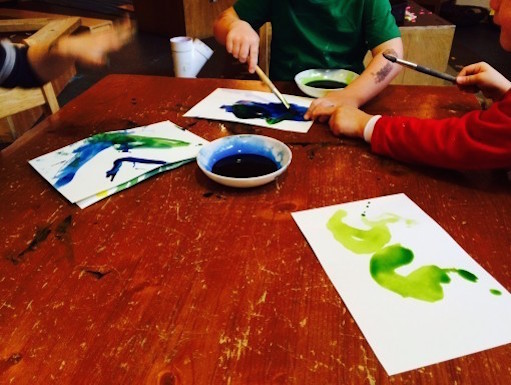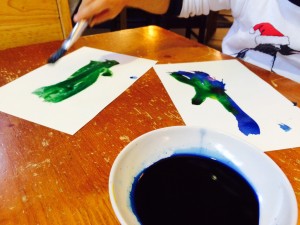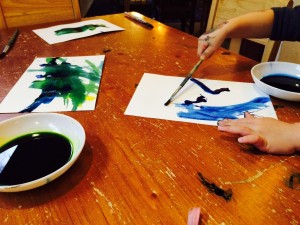
Interconnecting through Art
by Heather Cope, Educator, Hilltop Children’s Center
As the morning begins in the toddler room at Hilltop, it is quiet (surprisingly) and there are a few kids that are just now arriving for their new day of school. I wet some watercolor paper in the sink, and begin to place it out on the table for the kids to use. I find some paintbrushes and set them beside two bowls of watercolors, blue and yellow. Throughout one day, we put out ‘provocations’, or ‘invitations to learning’, for kids. A provocation is an invitation to the children to use a material and explore it in more depth. Kids that are interested in wet paper watercolors come over and begin to dip paintbrushes and talk and make noises with each other. More kids begin to notice the paint that is being set up, and soon after one or two kids come over to paint, it piques the interest of more kids. They become interested in the movement, excitement, and energy that bringing out the painting supplies create.
One kid takes a break from painting and notices, “Jennifer is making that! She is making that drawing.” Another child looks around at the other kids painting, notices how they are holding their brushes, how they are painting, then dives back into painting but on her neighbor’s paper. She then realizes that she can paint on her own and begins her own work, on her own paper. The kids all work on their own paintings quietly engaged and engrossed in their own world. At this point, one of the children begins to make a joyful noise. “Ayayayayaaa… yayaya…” This playful and exclamatory noise draws in another child that is working across the room in a sandbox to the table where we are painting. He makes the same noise and the kids all laugh about it and begin to make the noise together.
The comfort level appears to grow as they watch and learn from each other. One child begins working as another watches. Then that next child begins their work. They all take moments out of their own work to notice what the other kids are doing. As they grow more comfortable, they begin to notice each other in a different way. This allows them the time to build relationships and a sense of community with all the kids in the room as they see their peers doing the same tasks, and figuring out the materials together. This community building with open-ended art making can be a way to link community building and resiliency in children. When the children are more comfortable with each other, and in turn their environment, they are more willing to take bigger chances and then are more able to express themselves fully. They do not hold back experiments in fear of rejection of peers, or disapproval of teachers.
Art is a tool that can be powerful for any age. It has the power to stretch us outside of our comfort zone, as well as where we might go to seek comfort all at the same time. For young children (preschoolers/toddlers), art can have a profound impact on their comfort as they enter into a new space, and works quickly to build relationships and community. Some ways that we might further this line of community building would be to integrate more social art making. Perhaps that means using the same canvas to paint on to create a new level of closeness, or to change the location of the painting. We will continue to watch the changes of the children to direct us to our next provocation.
I’d love to hear your thoughts:
- What expressive media have you tried, to connect children with each other through making art?
- Have you had experiences, as an adult, where creative activities (dancing, karaoke, writing, painting, singing…) have helped you connect with others?
[author] [author_image timthumb=’on’]https://hilltopcc.com/wp-content/uploads/2014/12/Heather.jpg[/author_image] [author_info]Heather Cope is an educator with two-year-olds at Hilltop Children’s Center, where she has worked since 2013.[/author_info] [/author]
1 thought on “Interconnecting through Art”
Comments are closed.
Thanks for these reflections, Heather. Earlier in the year, when we noticed children becoming increasingly possessive of their artwork, we repeatedly set up collaborative painting experiences. A tin foil-covered table with paints and brushes nearby, a smaller canvas with thinner brushes, a flower pot that everyone could decorate — all in the name of creating art together. We found that two or three kids would begin combining their paintings and even overlapping their brush strokes to articulate joint designs. Once we changed the platform, children were much less interested in “Don’t touch mine!” and much more interested in “Can I paint with you?” It connected children in a different way and allowed them to focus on the process of painting, rather than the proprietorship. There is a place for individual artwork, of course. Collaborative art only strengthens one’s skills and expands one’s imagination, so why not encourage that, too? I love thinking about how it has a ripple effect on everything else they are learning and doing — and for us, the adults!